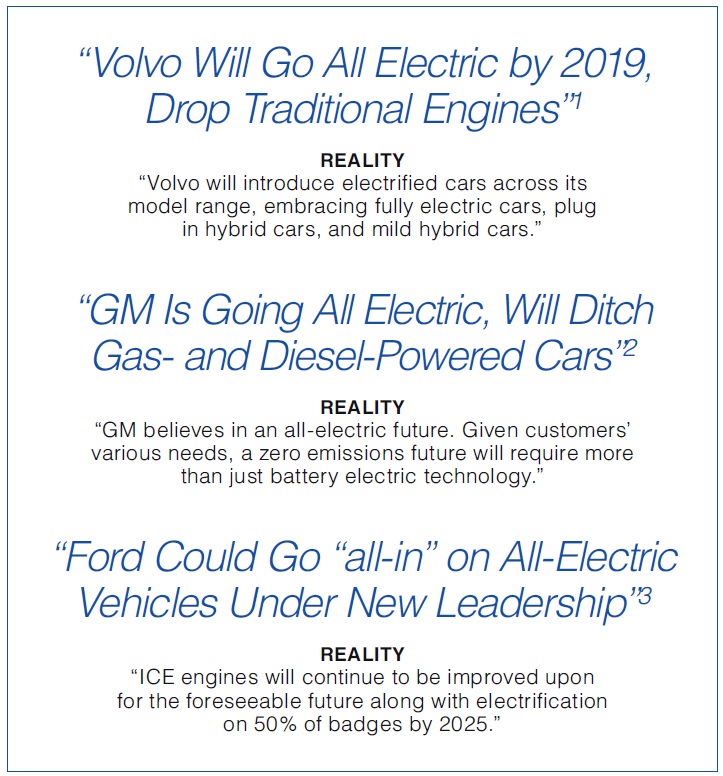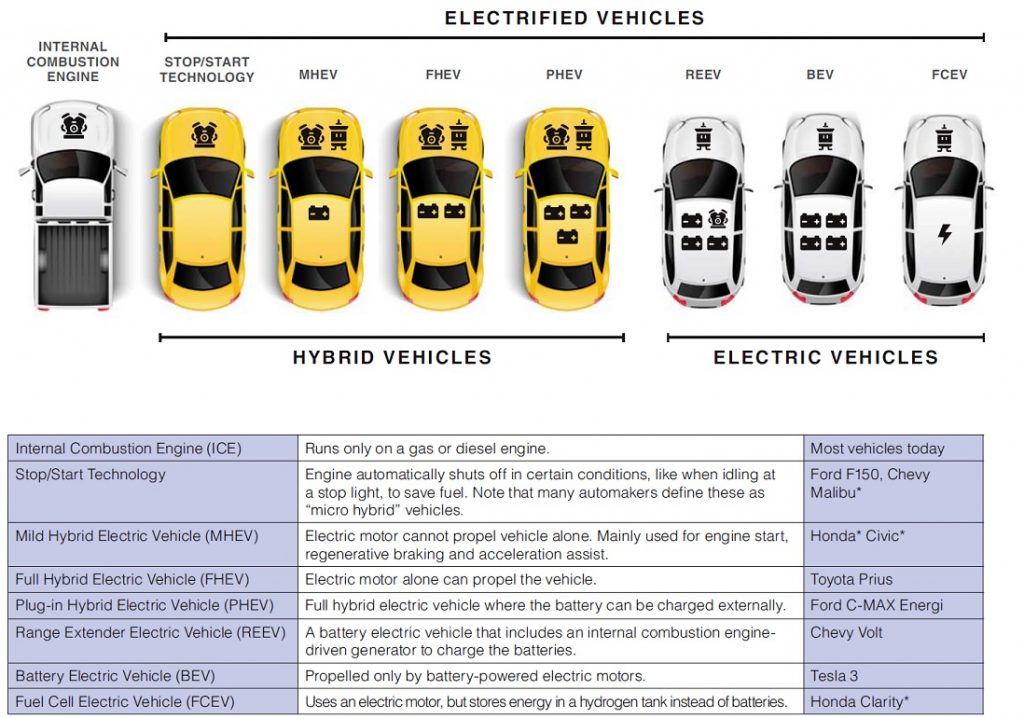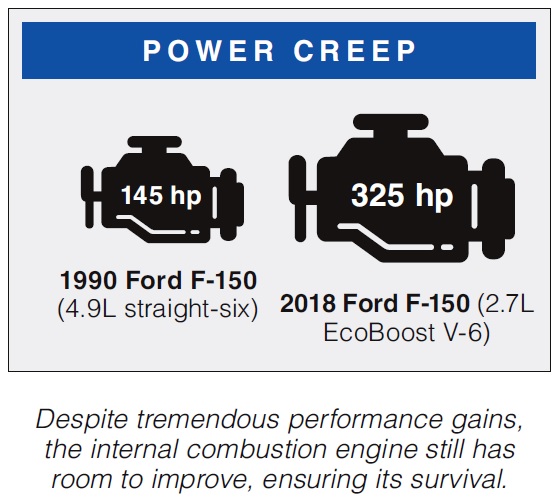Every day, it seems, another headline heralds the demise of the internal-combustion engine. The current narrative has scores of automakers and motorists abandoning their traditional vehicles – and the lubricants they use – in favor of electric vehicles, a scenario that has many enthusiasts wondering if the vehicles they love will still be around in the years ahead.
We dug past the headlines and consulted nearly 40 studies, reports and articles to gain insight into how electric vehicles may reshape the automotive landscape. Reality, it turns out, is far different than the picture painted in the media. Here, we present five key points that clarify the confusion surrounding the electric vehicle market.
The bottom line? Although the technology that powers our vehicles will change, an estimated 92 percent of vehicles on the road worldwide in 2030 will still use an internal combustion engine (ICE) in some capacity.
1. Headlines are Misleading
Headlines are crafted to grab your attention and elicit clicks. Unfortunately, most people glance at a headline in their news feed, react to it and move to the next one without reading the story. To get to the truth about the future of electrification, it’s critical that you read each story carefully and understand the motivation of its source.
In the table below, we show just three headlines that turned heads recently. Adjacent to each is what the automaker in question really said.

2. “Electric” and “Electrified” are Vastly Different
That brings us to point #2. You’ll notice that Volvo* said it plans to introduce “electrified” cars by 2019. Likewise, GM* said it believes in an “all-electric” future, while Ford* has thrown its support behind “electrification.” The difference between the terms can’t be overstated.
Electric Vehicles
An electric vehicle can plug into a charging station to recharge batteries that run electric motors used to propel the vehicle. They include battery electric vehicles (BEVs), like the Nissan* Leaf* and Tesla* 3, as well as hybrid vehicles like the Chevy* Volt*. Note that some “electric” vehicles still use an ICE.
Electrified Vehicles
Electrified vehicles, on the other hand, include a much larger swath of the overall vehicle market. They include the “electric” vehicles mentioned above, as well as vehicles that have an electric motor somewhere in the drivetrain. This includes conventional hybrids that don’t have plugs and are capable of running on all-electric power for only a few miles, like the Toyota* Prius*. The category also includes “micro hybrids,” which can include vehicles with stop-start technology. By this definition, a full-size pickup truck with stop-start technology is considered an “electrified” vehicle and, if the media outlet reporting the story doesn’t understand the difference, they sometimes call it an “electric” vehicle. So, if an automaker announces a move toward “electrification” in the future, the media outlet may confuse the terms and assume the automaker is abandoning internal-combustion engines. This is completely false. Likewise, an “all-electric” future includes electrified vehicles that still use an ICE.
Just as important, an automaker’s move to electrification for future models doesn’t necessarily mean it’ll quit manufacturing its current lineup of traditional vehicles. Volvo, for example, will continue making its current gas and diesel vehicles for the foreseeable future.

3. Most Electrified Vehicles Still Use Engines

Our research, which is based on nearly 40 studies, reports and articles from a wide range of sources, reveals that an estimated 92 percent of vehicles on the road worldwide in 2030 will still use an internal combustion engine, whether to propel the vehicle solely or working in unison with batteries and electric motors to improve efficiency.
4. Motorists Favor Traditional Vehicles by a Huge Margin
Admittedly, predictions can miss the mark. But current sales figures are clear: Despite government incentives that reward people for buying them, electric and hybrid vehicles represent less than 1 percent of market share in the U.S. and Canada. In 2017, pickup trucks accounted for the top three selling vehicles in the U.S. and the top two selling in Canada. In fact, for every BEV/PHEV sold in the U.S. in 2016, Ford* sold 6.3 F-series pickups. Motorists clearly aren’t ready to trade in their traditional vehicles for the current crop of EVs.
Much electrified vehicle growth is a result of government incentives – not consumer interest- such as a $7,500 tax credit for U.S. buyers. If those incentives expire, the bottom could fall out of the market. U.S. government officials tried to eliminate the credit in the most recent tax bill, but it survived. That doesn’t mean they won’t try again. Take away the financial incentive to buy an electric or hybrid vehicle, and the rate of growth will likely slow.
Research done by AAA determined that cost of ownership is a huge barrier to entry. Battery electric vehicles have the second-highest annual operating cost, largely due to rapid depreciation.
Range anxiety is another factor. Many motorists fear disruptions to their travel plans due to insufficient charging stations and infrastructure across the U.S. and Canada. Planning trips around charging- station availability leads to a negative experience. Until battery technology becomes less expensive and more advanced, electric vehicles will remain a tough sell to most motorists.

5. The Internal Combustion Engine has Room to Grow

One reason ICEs will remain is the tremendous leaps in
performance, efficiency and cleanliness they continue to make. A modern four-cylinder, turbocharged, gasoline direct-injected engine can make more power and torque than a six-cylinder engine of yesteryear while producing fewer emissions and using less fuel. Despite these advancements, there’s still room for improvement. The new Infinity’ variable-compression-ratio engine, which can adjust compression based on operating conditions, hit the market this spring. Infinity claims a 10 – 15 percent fuel economy improvement over its competitors. Likewise, Mazda’ made headlines when it announced its hope to achieve 56 percent thermal efficiency with its new homogenous charge compression ignition (HCCI) engine, which brings the efficiency advantages of diesel engines to the gasoline market. If true, it would represent the most efficient ICE for cars in history. There is also room for improvement in other drivetrain components, like automatic transmissions. These developments, along with the current cost advantages to manufacture a traditional vehicle compared to a battery- powered vehicle, will incentivize automakers to continue using internal combustion engines, either alone or alongside electric motors, for the foreseeable future.
Once you get past the headlines, you can see that widespread use of electrification to boost efficiency isn’t going to eliminate the cars and trucks you love any time soon. Just like our founder, AI Amatuzio, embraced technological advancement in formulating the world’s first synthetic oil for automotive use, we’ll monitor the automotive market and be prepared to lead the charge toward innovation well into the future, regardless of how
tomorrow’s vehicles are powered.
1 https://www.cbsnews.com/news/volvo-will-go-all-electric-by-2019-drop-traditional-engines/
3 The original link for Ford is no longer available on the “Electrek” web site but here is one for the F150 electric prototype. https://electrek.co/2019/07/23/ford-f-150-electric-prototype-tow-train-carts/
Article from AMSOIL Preferred Customer Magazine, Summer 2018
